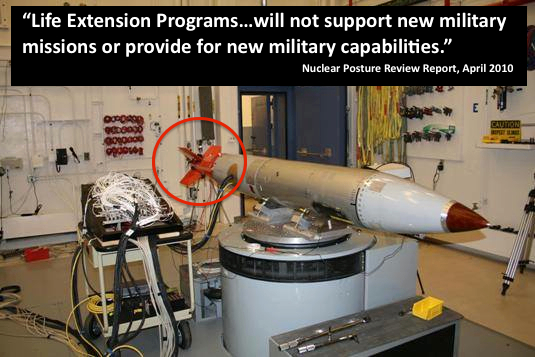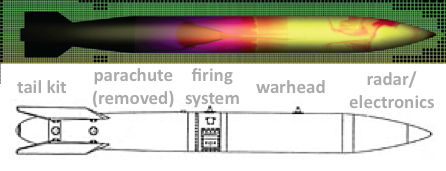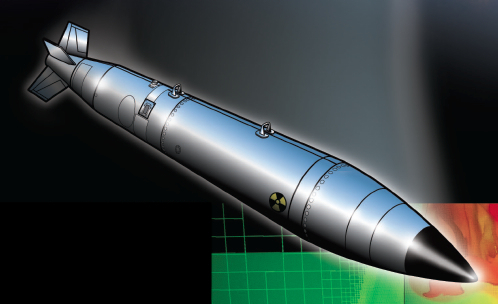B61-12: First Pictures Show New Military Capability

The guided tail kit of the B61-12 will create the first U.S. guided nuclear bomb.
Image: National Nuclear Security Administration. Annotations added by FAS.
By Hans M. Kristensen
The U.S. government has published the first images of the Air Force’s new B61-12 nuclear bomb. The images for the first time show the new guided tail kit that will provide new military capabilities in violation of the Nuclear Posture Review.
The tail kit will increase the accuracy of the bomb and enable it to be used against targets that today require bombs with higher yields.
The guided tail kit is also capable of supporting new military missions and will, according to the former USAF Chief of Staff, affect the way strike planners think about how to use the weapon in a war.
The new guided weapon will be deployed to Europe, replacing nearly 200 non-guided nuclear B61 bombs currently deployed in Belgium, Germany, Italy, the Netherlands, and Turkey.
Military Characteristics
The images show significant changes to the rear end of the bomb where the tail wing section has been completely replaced and the internal parachute removed. The length of the B61-12 appears to be very similar to the existing B61 (except B61-11 which is longer) although possibly a little bit shorter (see below).

The guided tail kit on the B61-12 (top) is replacing the fixed tail section on the existing B61 (bottom) and the parachute inside.
Source: Los Alamos National Laboratory/U.S. Air Force. Annotations added by FAS.
The new guided tail kit will not use GPS (global positioning system) but is thought to use an Internal Guidance System (INS). The precise accuracy is not known, but conventional bombs using INS can achieve an accuracy of 30 meters or less. Even if it were a little less for the B61-12, it is still a significant improvement of the 110-180 meters accuracy that nuclear gravity bombs normally achieve in test drops.
The tail kit will also provide the B61 with a “modest standoff capability” by enabling it to glide toward its target, another military capability the B61 doesn’t have today.
Inside the bomb, non-nuclear components will be refurbished or replaced. In the nuclear explosives package the B61-4 primary (pit) will be reused and the secondary remanufactured. Detonators will be replaced with a design used in the W88 warhead, conventional Insensitive High Explosives will be remanufactured, and a new Gas Transfer System will be installed to increase the performance margin of the primary.
The B61-4 warhead used in the B61-12 has four selectable yields of 0.3, 5, 10, and 50 kilotons. LEPs are not allowed to increase the yield of warheads but GAO disclosed in 2011 that STRATCOM “expressed a requirement for a different yield [and that] U.S. European Command and SHAPE [Supreme Headquarters Allied Powers Europe] agreed to the proposal.” It is unknown if the different yield is a modification of one of the three lower yield options or an increase of the maximum yield. During another upgrade of the B61-7 bomb to the B61-11 earth-penetrator, the yield was increased from 360 kilotons to 400 kilotons.
Although increasing safety and security were prominent justifications for securing Congressional funding for the B61-12, enhancements to the safety and security of the new bomb are apparently modest. More exotic technologies such as multi-point safety and optical detonators were rejected.
The complex upgrades add up to the most expensive U.S. nuclear bomb project ever – currently estimated at approximately $10 billion for 400-500 bombs.
Political Implications
Enhancing military capabilities of nuclear weapons (accuracy and yield) is controversial and Government officials in the United States and European capitals are trying to dodge the issue. The 2010 Nuclear Posture Review Report explicitly promised that “Life Extension Programs…will not support new military missions or provide for new military capability capabilities.” But the guided tail kit is a new military capability and so is a different explosive yield.
Military and government officials will privately admit to the change but the public line is that this is a simple life-extension of the existing B61 with no new military capabilities.
During a recent visit to Europe where I briefed the Dutch and Belgian parliaments on the status and implications of the B61 modernization, parliamentarians were concerned that this kind of clandestine nuclear modernization under the guise of life-extension is unacceptable at the national level and counterproductive at the international level. They said they had not been informed about the upcoming deployment of improved nuclear capabilities in their countries. Their governments’ position is that there is no improvement and therefore no need to inform anyone. But one Dutch government official told me in so many words that they haven’t actually checked but trust the United States would not introduce improved nuclear bombs in Europe without telling the allies. A Dutch parliamentarian said he knew for sure that the improved capability is known within the ministry of defense.
The parliamentarians were also concerned that improving the military capabilities sends the wrong message about NATO’s nuclear policy, in particular its promise to reduce nuclear weapons in Europe and seeking to create the conditions for a world without nuclear weapons. Deploying a new guided nuclear bomb on a new stealthy F-35 fighter-bomber in Europe will make it hard for NATO to argue that Russia should reduce and not improve its non-strategic nuclear posture.

The B61-12 will have a new military capability to glide toward its target.
Image: Los Alamos National Laboratory
Many NATO countries quietly favor a withdrawal of the U.S. nuclear weapons from Europe but feel hamstrung by NATO policy, which mistakenly confuses generic security concerns of some eastern European allies with a need for nuclear weapons in Europe. The security concerns obviously must be addressed but not with fake assurance by tactical nuclear bombs that are the least likely to ever be used in response to the kinds of security challenges that face Europe today.
NATO decided in 2012 “that the Alliance’s nuclear force posture currently meets the criteria for an effective deterrence and defense posture.” If so, why enhance it with guided B61-12 nuclear bombs and F-35 stealth fighter-bombers?
Additional information: previous articles about the B61-12
This publication was made possible by a grant from the Ploughshares Fund. The statements made and views expressed are solely the responsibility of the author.
The FY2026 National Defense Authorization Act (NDAA) paints a picture of a Congress that is working to both protect and accelerate nuclear modernization programs while simultaneously lacking trust in the Pentagon and the Department of Energy to execute them.
While advanced Chinese language proficiency and cultural familiarity remain irreplaceable skills, they are neither necessary nor sufficient for successful open-source analysis on China’s nuclear forces.
Satellite imagery has long served as a tool for observing on-the-ground activity worldwide, and offers especially valuable insights into the operation, development, and physical features related to nuclear technology.
This report outlines a framework relying on “Cooperative Technical Means” for effective arms control verification based on remote sensing, avoiding on-site inspections but maintaining a level of transparency that allows for immediate detection of changes in nuclear posture or a significant build-up above agreed limits.